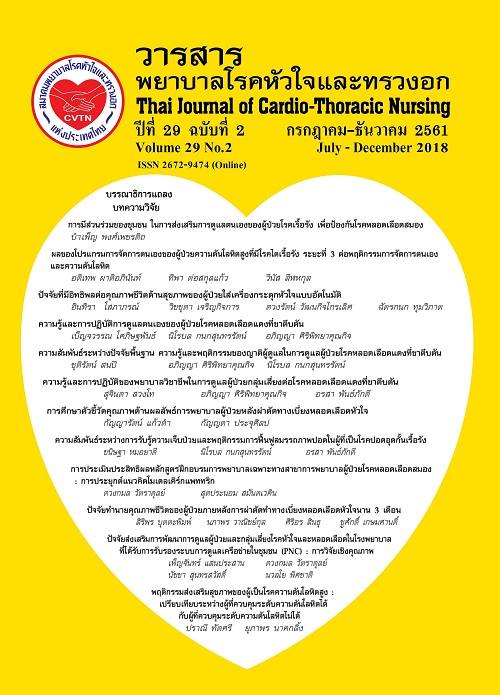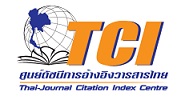Relationship between the caregivers’ basic conditioning factors, and knowledge, and the caregivers’ behavior towards patients with peripheral arterial occlusive disease
Keywords:
caregiver, basic conditioning factors, behavior, knowledge, peripheral arterial occlusive diseaseAbstract
This descriptive research was aimed at studying the relationship between the basic conditioning factors, knowledge about PAOD of the caregivers, and the caregivers’ behavior in caring for patients with PAOD. The conceptual framework used in this study was Orem’s Theory of Self-care Deficit. The sample was composed of 60 caregivers of PAOD patients seeking treatment in the Vascular Surgery Department in a university affiliated hospital. Data were collected using a personal data questionnaire, the PAOD knowledge questionnaire and the questionnaire on caregivers’ behavior in caring for patients with PAOD. Data were analyzed using descriptive statistics, Pearson's correlation coefficient and Spearman rank correlation coefficient.
According to the findings, most of the caregivers were females aged 30 – 72 years with bachelor’s degree. Nearly half of the sample had hypertension as a chronic disease. Most of the patients were males aged 60 – 95 years. The overall knowledge of the caregivers regarding PAOD was low. The overall caregivers’ behavior in caring for the patients with PAOD was high. The correlations between basic conditioning factors and caregivers’ behavior in caring for patients were not encountered, however, knowledge about PAOD of the caregivers and the caregivers’ behavior in caring for patients with PAOD were found to be significantly correlated (r = .038)
The findings of this study indicated that nurses should promote the caregivers in gaining knowledge about PAOD with emphasis on controlling metabolic risk factors, weight control and teaching skills in palpation of peripheral pulse, checking the feet, and observing abnormal symptoms from medications in order for caregivers to be able to assess, anticipate, and prevent complications from PAOD of patients.
References
2. Harris K. The worldwide burden of peripheral artery disease. J Vasc Surg. 2007; 45: 5-67.
3. American Heart Association. Atherosclerosis [homepage on the internet]. 2015 [cited 2016 Feb 19]. Available from: https://www.heart.org/HEARTORG/Conditions/Cholesterol/WhyCholesterolMatters/Atherosclerosis_UCM_305564_Article.jsp#.V3kgTLiLTIU.
4. Murabito J M, D'Agostino RB, Silbershatz H, Wilson WF. Intermittent claudication a risk profile from The Framingham Heart Study. Circulation. 1997; 96(1): 44-9.
5. Treat-Jacobson D, Walsh ME. Treating patient with peripheral arterial disease and claudication. J Vasc Nurs. 2003; 21(1): 5-14.
6. McDermott MM, Fried L, Simonsick E, Ling S, Guralnik JM. Asymptomatic peripheral arterial disease is independently associated with impaired lower extremity functioning The Women’s Health and Aging Study. Circulation. 2000; 101: 1007-12.
7. Mutirangura P. Emergency vascular surgery. Bangkok: Aksorn sampan press, 2010. (in Thai).
8. Ouriel, K. Peripheral arterial disease. Lancet. 2001 Oct 13;358(9289):1257-64.
9. Lawang W, Sunsern R, Rodjarkpai Y. Evidences and needs of family caregiver with chronically ill adults. Journal of Phrapokklao Nursing College .2004; 15(2): 17-31. (in Thai).
10. Hanucharurnkul S. Nursing: the science of practice, 2nd edition. Bangkok: V.J. printing limited partnership; 2001. (in Thai).
11. Srisuk S. Factors affecting behavior caring diabetics at the relative’s house in Ubon Ratchathani. Journal of Srivanalai Research. 2013; 3(5): 74-83. (in Thai).
12. Itthakom, S. Factors related to caregivers' help with medication adherence of persons with hypertension. [Master of Nursing Science]. Bangkok: Mahidol University; 2006. (in Thai).
13. Chalardsuntomwatee N. Self - care burden in post acute myocardial infarction patients. [Master of Nursing Science]. Bangkok: Mahidol University; 1996. (in Thai).
14. Kespichayawattana J. "Katanyu Katavedi" and caregiveing for frail elderly parents: the perspectives of Thai families in Metropolitan Bangkok, Thailand. Journal of Nursing Science Chulalongkorn University .1999; 11(3): 51-64. (in Thai).
15. Jirojanakul P. Nursing research: concepts, principles and methods. Nonthaburi: Academic Welfare Program of Phraboromarajchanok Institute; 2005. (in Thai).
16. Information Service Unit, Information Warehouse Ramathibodi Hospital. Statistics of inpatients with peripheral arterial occlusive disease. Bangkok : Ramathibodi Hospital ; 2012. (in Thai).
17. Bloom, B.S. Learning for mastery. Evaluation Comment 1968; 1(2): 29-62.
18. Lackey NR, Wingate AL. The pilot study: One key to research success. In: Brink PJ, Wood MJ, editors. Advanced Design in Nursing Research. 2nd ed. Thousand Oaks: Sage; 1998.
19. Sirapo-ngam Y. A survey of family caregiving research in Thailand. Ramathibodi Nursing Journal. 2003; 9(2): 156-65.
20. Yodpet S. Elderly caregiver in the family. Documentation for the Brainstorming Session on Policy Issues "Care system and manpower in caring for the elderly"; 2008 Oct 30; Chulabhorn Research Institute Convention center, Bangkok [document on the Internet]. 2008 [cited 2017 apr 25]. Available from https://thaitgri.org/images/document/Research_tgri/FamilyResearch.pdf
21. Watcharasiribunlue W. Factors related to caregivers' abilities in stroke patients' medication taking. [Master of Nursing Science]. Bangkok: Mahidol University; 2011. (in Thai).
22. Mutirangura P, Ruangsetakit C, Wongwanit C, Sermsathanasawadi N, Chinsakchai K. Atherosclerosis obliterans of the lower extremities in Thai patients. J Med Assoc Thai. 2006; 89(10): 1612 – 19.
23. Kanchanasuttirak P, Kanchanabat B, Stapanawatr W, Wongmahsorn Y. Survival of patients after peripheral bypass surgery for critical limb ischemia. Vajira Medical Journal. 2012; 56(3): 217-226.
24. Thangrod R., Kimpee S,Thosingha O, Ruangsetakit C. Factors predicting health status in patients afterinfrainguinal bypass. Journal of Nursing Science. (Supplement). 2010; 28(4): 46-54.
25. Sritara P, Sritara C, Woodward M, Wangsuphachart S, Barzi F, Hengprasith B, et al. Prevalence and risk factors of peripheral arterial disease in a selected Thai population. Angiology. 2007; 58: 572-8.
26. Mutirangura P. Aortoiliac Occlusive Disease. In: Jirasiritham S, Trairatvorakul P, Laohapensang K, Mutirangura P, editors. Textbook of vascular surgery volume 2. Bangkok: Bangkok Wetchasan Printing House; 2006. (in Thai).
27. Regensteiner J G, Hiatt W R. Treatment of peripheral arterial disease. Am. J. Med. 2002; 112: 49-57.
28. Money SR., Herd JA., Isaacsohn JL, Davidson M, Cutler B, Heckman J, et al. Effect of cilostazol on walking distances in patients with intermittent claudication caused by peripheral vascular disease. J Vasc Surg. 1998; 27(2): 267-74.
29. Collinson DJ, Donnelly R. Cilostazol: improving walking distance in patients with intermittent claudication. Expert Rev Cardiovasc Ther. 2004 Jul;2(4):503-9.
30. Intarasombat P. Self-care in Patients with chronic illness. In: Hanucharurnkul S, editor. Self-care: Science and art of nursing. 6th ed. Bangkok: V.J. printing limited partnership; 2001. (in Thai).
31. Schwarcz AI, Quijano A, Olin JW, Ostfeld RJ. Internal medicine interns have a poor knowledge of peripheral artery disease. Angiology. 2012; 63(8): 597-602.
32. Senachai N, Panpakdee O, Siripitayakunkit A. Relationship among Nurses’ Basic Conditioning Factors, Knowledge, and Competency for Providing Care of Patients at Risk of Peripheral Arterial Disease. Thai Journal of Cardio-Thoracic Nursing. 2014; 25(2): 2-16. (in Thai).
33. Orem DE, Taylor SG, Renpenning KM. Nursing concepts in practice. St. Louis: Mosby; 2001.
Downloads
Published
How to Cite
Issue
Section
License
บทความนี้ยังไม่เคยตีพิมพ์หรืออยู่ในระหว่างส่งไปตีพิมพ์ในวารสารอื่น ๆ มาก่อน และกองบรรณาธิการขอสงวนสิทธิ์ในการตรวจทาน และแก้ไขต้นฉบับตามเกณฑ์ของวารสาร ในกรณีที่เรื่องของท่านได้ได้รับการตีพิมพ์ในวารสารฉบับนี้ถือว่าเป็น ลิขสิทธิ์ของวารสารพยาบาลโรคหัวใจและทรวงอก






